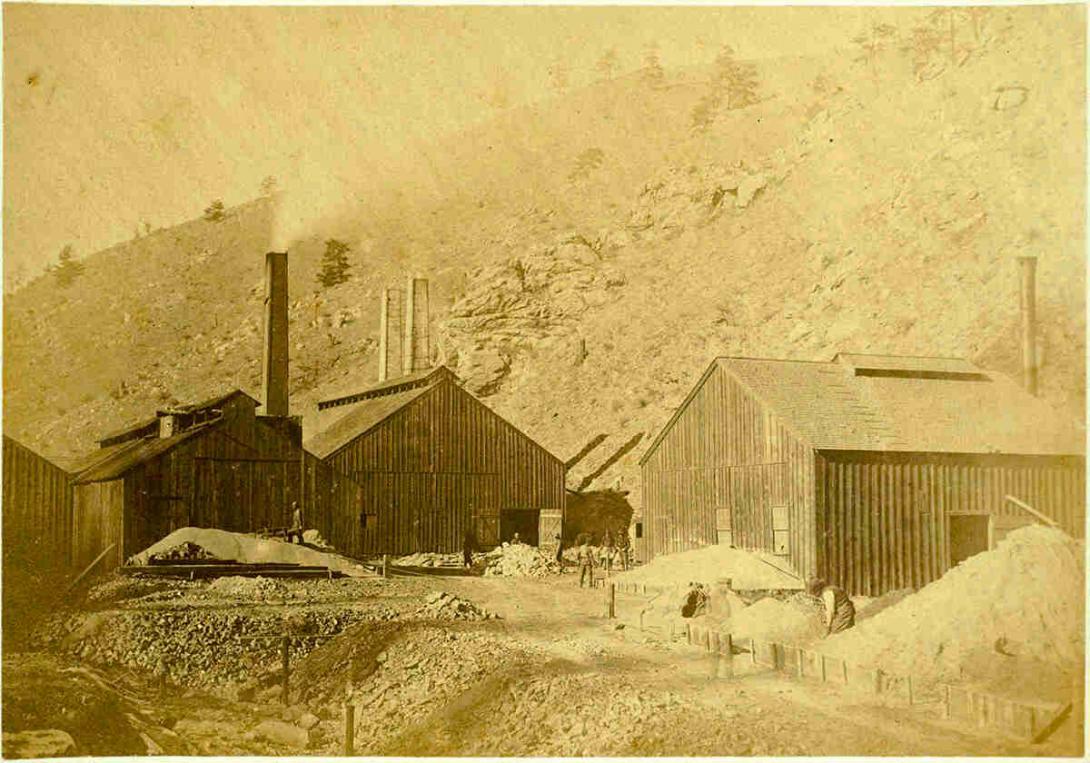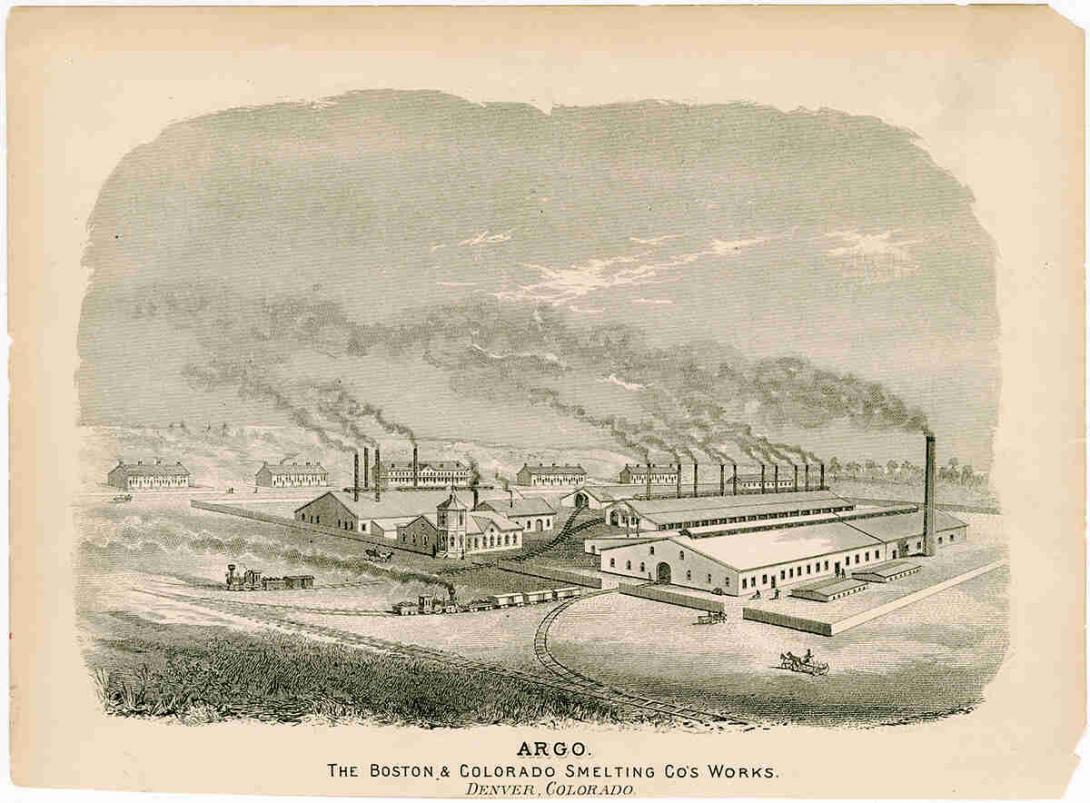Nathaniel P. Hill
Full Article
Nathaniel Peter Hill (1832–1900) was a mining entrepreneur and US senator from Colorado. In the 1860s, Hill, an accomplished chemist and metallurgist, bought mining interests in Black Hawk and developed the first successful smelter in Colorado, revolutionizing the mining industry in the fledgling territory and beyond.
A Chemist Heads West
Hill was born on February 18, 1832, into a distinguished family in Montgomery, New York. By the 1860s, he was a professor of chemistry at Brown University, where he established the campus’s first chemistry lab for students. In 1864 he made his first journey westward to survey potential mining opportunities in Colorado Territory. His education in chemistry and interest in metallurgy made him the perfect candidate to inspect the lands bounded by the Sangre de Cristo Grant, which was owned by former Colorado governor William Gilpin. In 1864 Colonel William Reynolds, an investor in the property, hired Hill to inspect the land for traces of mineral deposits. Hill presumably found no mineral value in the land; Hill submitted his report to Reynolds, and the colonel sold his interest in the property.
The Smelting Solution
Although his first survey came up empty, Hill’s visit to Colorado sparked his interest in mining as well as his entrepreneurial spirit. He quit his job at Brown and purchased a house and mining property in Black Hawk. His arrival was fortuitous for Colorado’s mining industry, which was struggling at the time. The first wave of prospectors in the Colorado Gold Rush of 1858–59 had mostly used the placer method, panning out loose surface gold from streams. By the 1860s, most of the placer gold had been panned out, so miners began digging tunnels and extracting ore—rock containing precious metals. To free the metals bound to the rock, miners in Black Hawk and other frontier mining towns used a process called stamp milling, in which they crushed the ore with giant metal stamps and then sluiced the metals away from the pulverized rock. However, as miners dug deeper into the earth, they encountered more complex types of ore that stamp mills could not efficiently extract.
Hill recognized that Colorado’s gold miners needed a new extraction method. In search of solutions, he turned to smelting, a process of metal extraction that uses heat to melt the precious metals in ore, allowing for more efficient removal. With the backing of Eastern investors, he arranged for a few tons of ore to be transported to a famous smelter in Swansea, Wales. The Swansea smelter successfully processed his shipment of Colorado ore, and in 1867 he secured investors to build his own smelter in Black Hawk using the Swansea process. They founded the Boston and Colorado Smelting Company and opened Colorado’s first successful smelter in January 1868. Hill and his family officially moved from Providence to Black Hawk later that year.
Smelting revitalized the territory’s dormant mining industry. In the decade before Hill’s smelter opened, miners in Gilpin County had extracted a total of $9.4 million in gold. In the decade after Hill’s smelter opened, Gilpin County miners more than doubled their gold production to $20.2 million. Hill’s company ruled Colorado’s smelting industry in those years, and Hill also acquired mining interests in Central City that saw great success.
From Mining to Politics
Hill’s reputation as the savior of Colorado’s mining industry firmly established, he decided to enter politics in 1871. That year, he was elected mayor of Black Hawk, a position he held until 1873. He also served as a member of the Colorado Territorial Legislature in 1872–73. In 1879 the state legislature elected Hill, a Republican, to the US Senate. He served for a single six-year term before being defeated in a reelection bid by Henry Teller. During his time in the Senate, Hill served as chairman of the committee on mines and mining and sat on the committee for post offices and post roads.
In 1879 Hill wanted a more central location for his business and decided to move the Boston and Colorado Smelting Company from Black Hawk to Denver. He also decided to rename the smelter “Argo” after the legendary ship that sailed in search of the fabled Golden Fleece in Greek mythology. Hill and his business associates built the Argo smelter two miles north of Denver, where it continued to thrive.
After relocating his business, Hill moved his family from Black Hawk to the capital city. The Hills purchased a twenty-room, three-story mansion at Fourteenth and Welton Streets, an area that was considered at the time to be the city’s first “upper-crust” neighborhood. The Hills’ neighbors included the Evanses, the Byers, and the Iliffs.
After his move to Denver, Hill expanded his business interests. He acquired real estate and helped develop property around the growing city. In 1887 he helped form the Denargo Land Company and served as its president. He also served as president of the United Oil Company and purchased a local newspaper, the Denver Republican. In his later years, he sat on the board of trustees of the Colorado School of Mines, where he also taught classes.
Death and Legacy
Hill died in Denver of a stomach disease on May 22, 1900. He was remembered as energetic and kind, finding success in almost all his endeavors because of his remarkable work ethic and intelligence. His establishment of the Boston and Colorado revolutionized the mining industry not just in Colorado but across the entire West. His work in the mining industry, as well in the various other influential positions he held within the state, made him one of the most important individuals in Colorado history. In recognition of Hill’s influence in Colorado, he was chosen as one of the sixteen individuals depicted in stained glass as part of the Colorado Hall of Fame in the state capitol dome.
Today Hill’s legacy appears mixed. The smelting process he introduced to Colorado made vital contributions to the state’s early development, yet it also contaminated groundwater and soil with toxic heavy metals. Coloradans continue to live with the harsh environmental consequences. The site of Hill’s Argo smelter in Denver, for example, was listed as a Superfund site in 1999. Despite years of testing and cleanup efforts, a 2017 study found that the nearby Globeville and Elyria-Swansea neighborhoods remain the most environmentally hazardous populated areas in the United States.








